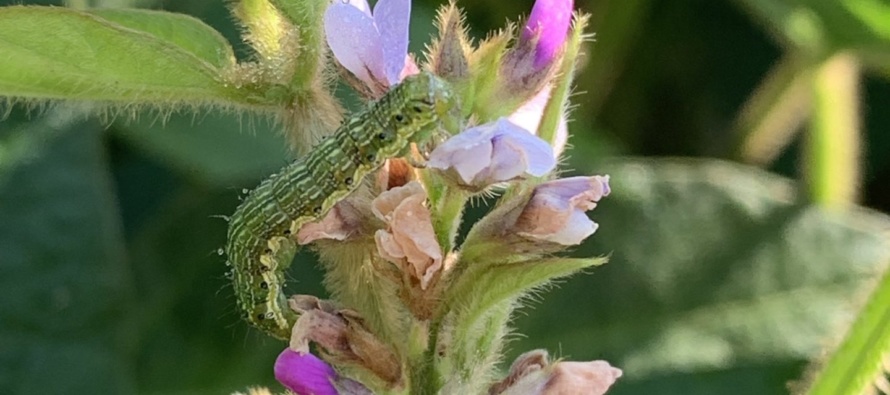Bollworm Management in Soybeans and Cotton

Related Articles
- 2010 Soybean And Corn Variety Trial Data 3
- Fertilizing Cotton with Poultry Litter 5
- Mississippi Cotton Insect Situation of 2010: A Look Back 3
Latest Tweets
Bollworm Management in Soybeans
Early July starts the onset of the bollworm flight into Mississippi row crops. At this point, bollworms have been observed in a some areas of the state in R2-R3 soybeans. Most of the larvae being found are small. Mortality of small bollworm in soybeans can be high, which is why larvae smaller than ½ inch are generally not included in counts for determining if threshold has been exceeded. The current dynamic thresholds for sweep net and drop cloth sampling are defined in Tables 1 and 2, respectively. The static thresholds are 9 larvae / 25 sweeps (sweep net) and 1-1.5 larvae per row foot (drop cloth). Also, soybeans can compensate for flower and pod loss, especially when this occurs during the early reproductive stages (R2-R3). This is illustrated in Figure 1, which is from Dr. Brian Adams’s dissertation work. Control options for bollworm in soybeans are diamides (Vantacor, Besiege, Elevest, etc.) and Intrepid Edge. Pyrethroids and pyrethroids plus acephate have been inconsistent for several years, and these treatments can exacerbate infestations by other insect pests, such as the soybean looper.
Table 1. Economic threshold for bollworm/corn earworm larvae based on sweep net sampling.
|
Larvae/25 sweeps |
|||||
|
Control costs ($/acre, including application costs) |
|||||
|
Crop value ($/bu) |
10 |
15 | 20 | 25 |
30 |
|
8.0 |
5.5 | 8.3 | 11.0 | 13.8 |
16.5 |
|
9.0 |
4.9 | 7.4 | 9.8 | 12.3 | 14.7 |
| 10.0 | 4.4 | 6.6 | 8.8 | 11.0 |
13.2 |
|
12.0 |
3.7 | 5.5 | 7.4 | 9.2 | 11.0 |
| 13.0 | 3.4 | 5.1 | 6.8 | 8.5 |
10.2 |
|
14.0 |
3.2 | 4.7 | 6.3 | 7.9 | 9.5 |
| 15.0 | 2.9 | 4.4 | 5.9 | 7.4 |
8.8 |
| 16.0 | 2.8 | 4.1 | 5.5 | 6.9 |
8.3 |
Table 2. Economic threshold for bollworm/corn earworm larvae based on drop cloth sampling.
|
Larvae/row foot |
|||||
|
Control costs ($/acre, including application costs) |
|||||
| Crop value ($/bu) | 10 | 15 | 20 | 25 |
30 |
|
8.0 |
0.7 | 1.1 | 1.5 | 1.8 | 2.2 |
| 9.0 | 0.7 | 1.0 | 1.3 | 1.6 |
2.0 |
|
10.0 |
0.6 | 0.9 | 1.2 | 1.5 | 1.8 |
| 12.0 | 0.5 | 0.7 | 1.0 | 1.2 |
1.5 |
|
13.0 |
0.5 | 0.7 | 0.9 | 1.1 | 1.4 |
| 14.0 | 0.4 | 0.6 | 0.8 | 1.0 |
1.3 |
| 15.0 | 0.4 | 0.6 | 0.8 | 1.0 |
1.2 |
| 16.0 | 0.4 | 0.5 | 0.7 | 0.9 |
1.1 |
 Figure 1. Impact of manual fruit (flowers and pods) removal (0%, 50%, or 100%) at different growth stages on soybean yield.
Figure 1. Impact of manual fruit (flowers and pods) removal (0%, 50%, or 100%) at different growth stages on soybean yield.
Bollworm Management in Cotton
The increase in bollworm activity also coincides with much of the cotton across the state entering bloom. The majority of cotton varieties planted in Mississippi is 3rd generation Bt technology (Bollgard 3, Widestrike 3, TwinLink +). As we continue to move beyond 2nd-generation cotton varieties (Bollgard 2), bollworm management should occur based on larval counts or damage fruit counts rather than an egg-lay threshold. Trials conducted across the Midsouth during 2024 indicated there was no economic benefit of triggering insecticide applications on egg-lay for the control of bollworms in 3-gene cotton varieties. This is not to say that 3-gene cotton varieties will never need insecticide applications. If 3-gene cotton reaches 4 larvae (1/8 inch or greater) per 100 plants or 6% fruit injury of any kind, an insecticide application is warranted. The diamide insecticides (Vantacor, Elevest, Besiege) continue to perform very well in field trials and provide the longest residual effect; however, alternative options include Intrepid Edge, Steward, and Orthene, along with a pyrethroid. As always, rotation of these chemistries is of utmost importance.





Let me tell You a sad story ! There are no comments yet, but You can be first one to comment this article.
Write a comment